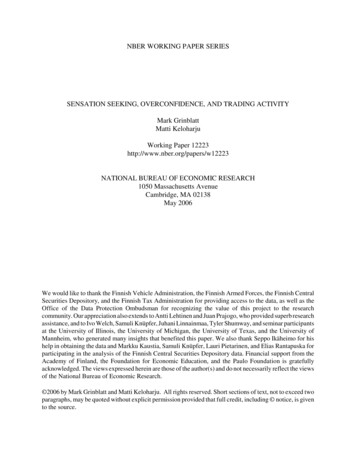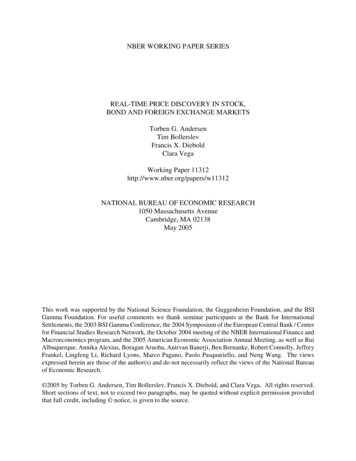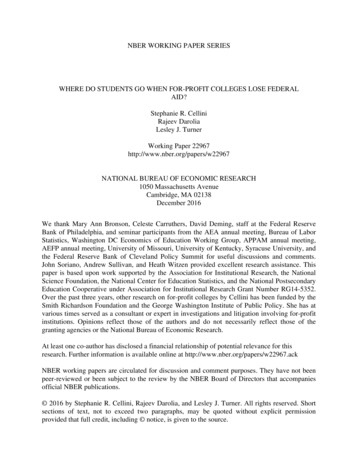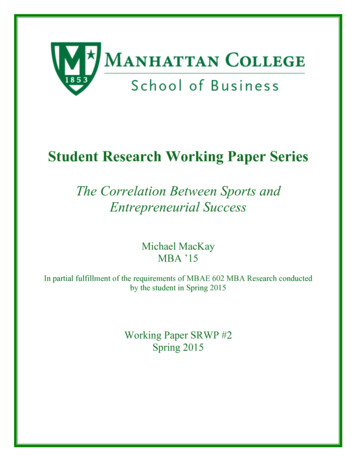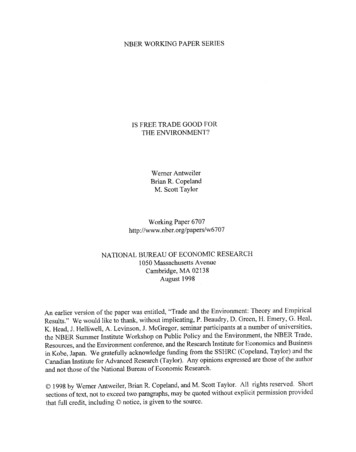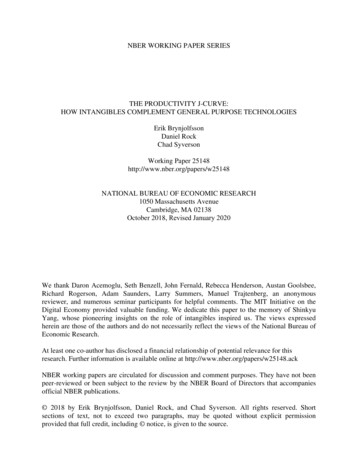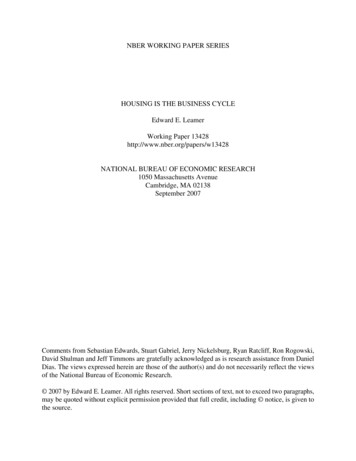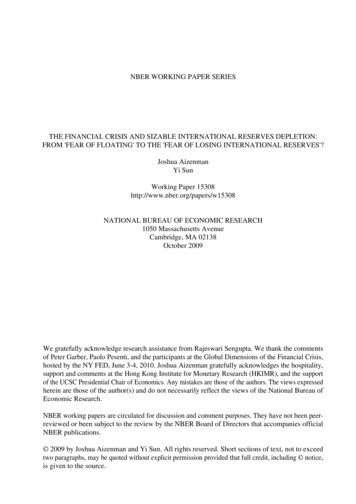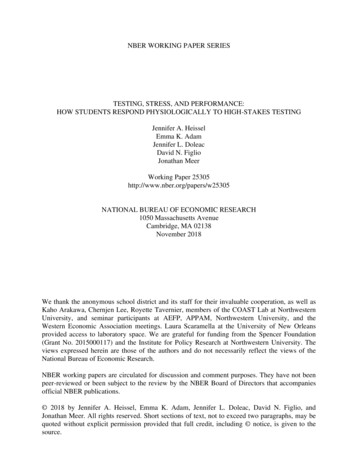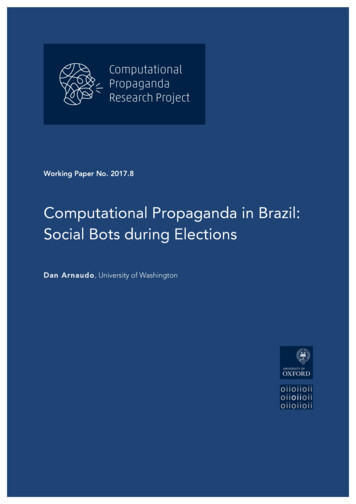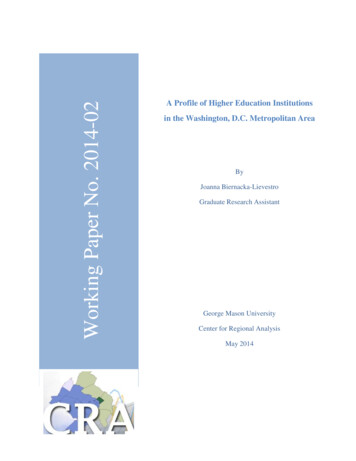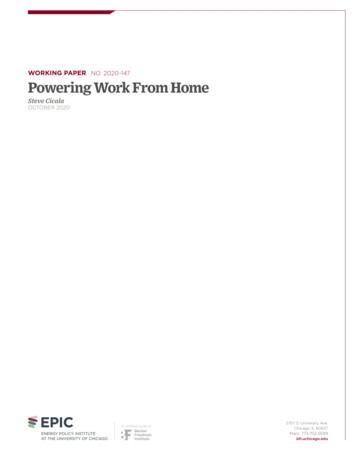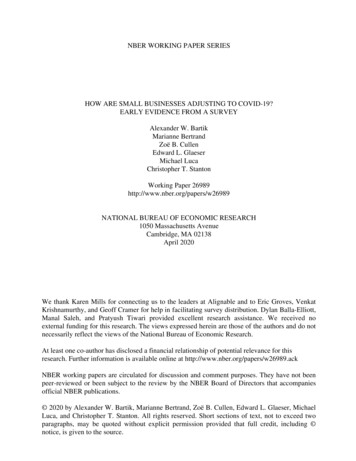
Transcription
NBER WORKING PAPER SERIESHOW ARE SMALL BUSINESSES ADJUSTING TO COVID-19?EARLY EVIDENCE FROM A SURVEYAlexander W. BartikMarianne BertrandZoë B. CullenEdward L. GlaeserMichael LucaChristopher T. StantonWorking Paper 26989http://www.nber.org/papers/w26989NATIONAL BUREAU OF ECONOMIC RESEARCH1050 Massachusetts AvenueCambridge, MA 02138April 2020We thank Karen Mills for connecting us to the leaders at Alignable and to Eric Groves, VenkatKrishnamurthy, and Geoff Cramer for help in facilitating survey distribution. Dylan Balla-Elliott,Manal Saleh, and Pratyush Tiwari provided excellent research assistance. We received noexternal funding for this research. The views expressed herein are those of the authors and do notnecessarily reflect the views of the National Bureau of Economic Research.At least one co-author has disclosed a financial relationship of potential relevance for thisresearch. Further information is available online at http://www.nber.org/papers/w26989.ackNBER working papers are circulated for discussion and comment purposes. They have not beenpeer-reviewed or been subject to the review by the NBER Board of Directors that accompaniesofficial NBER publications. 2020 by Alexander W. Bartik, Marianne Bertrand, Zoë B. Cullen, Edward L. Glaeser, MichaelLuca, and Christopher T. Stanton. All rights reserved. Short sections of text, not to exceed twoparagraphs, may be quoted without explicit permission provided that full credit, including notice, is given to the source.
How Are Small Businesses Adjusting to COVID-19? Early Evidence from a SurveyAlexander W. Bartik, Marianne Bertrand, Zoë B. Cullen, Edward L. Glaeser, Michael Luca,and Christopher T. StantonNBER Working Paper No. 26989April 2020JEL No. E65,I12,L20ABSTRACTIn addition to its impact on public health, COVID-19 has had a major impact on the economy. Toshed light on how COVID-19 is affecting small businesses – and on the likely impact of therecent stimulus bill, we conducted a survey of more than 5,800 small businesses. Several mainthemes emerge from the results. First, mass layoffs and closures have already occurred. In oursample, 43 percent of businesses are temporarily closed, and businesses have – on average –reduced their employee counts by 40 percent relative to January. Second, consistent with previousliterature, we find that many small businesses are financially fragile. For example, the medianbusiness has more than 10,000 in monthly expenses and less than one month of cash on hand.Third, businesses have widely varying beliefs about the likely duration of COVID relateddisruptions. Fourth, the majority of businesses planned to seek funding through the CARES act.However, many anticipated problems with accessing the aid, such as bureaucratic hassles anddifficulties establishing eligibility.Alexander W. BartikUniversity of Illinois1407 W. Gregory Road214 David Kinley HallUrbana, IL 61821abartik@illinois.eduMarianne BertrandBooth School of Business Universityof Chicago5807 South Woodlawn AvenueChicago, IL 60637and NBERmarianne.bertrand@chicagobooth.eduZoë B. CullenRock Center 210Harvard Business School60 N. HarvardBoston, MA 02163zcullen@hbs.eduEdward L. GlaeserDepartment of Economics315A Littauer CenterHarvard UniversityCambridge, MA 02138and NBEReglaeser@harvard.eduMichael LucaHarvard Business SchoolSoldiers FieldBoston, MA 02163and NBERmluca@hbs.eduChristopher T. Stanton210 Rock CenterHarvard UniversityHarvard Business SchoolBoston, MA 02163and NBERchristopher.t.stanton@gmail.com
1. IntroductionHow are America’s small businesses navigating the economic disruptions resulting fromCOVID-19, and how will the CARES Act affect their decisions and future prospects? To explorethese questions, we conducted a survey of more than 5,800 small businesses that were membersof the Alignable business network. The survey focused on assessing (1) the current level offinancial fragility among small businesses, (2) the extent to which small businesses have alreadytemporarily closed and laid off employees, (3) expectations about how long the crisis will last and how this is affecting business decisions, and (4) decisions about whether to seek fundingthrough the CARES Act, and how this will impact layoff and closure decisions. In this shortnote, we present the survey results and themes that emerge.Overall, our results suggest that the pandemic has already caused massive dislocationamong small businesses. While businesses’ beliefs about the duration of the crisis vary widely,the median business owner expects the dislocation to last well into mid-summer. Businesses areadjusting in a variety of ways, and over seventy percent of respondents anticipate takingadvantage of aid when asked about a program that resembles the Paycheck Protection Program(PPP) that is part of the CARES act. Moreover, they expect this funding to influence otherbusiness decisions – including layoff decisions and staying in business altogether. At the sametime, many businesses were reluctant to apply for funding through the CARES Act because ofconcerns about administrative complexity and eligibility.This note proceeds as follows. Section 2 discusses the survey design. Section 3 discussesthe characteristics of the firms that responded to the survey and their representativeness. Oursurvey was conducted through Alignable, a network of 4.6 million small businesses, and wasincluded as a link in a March 26, 2020 email to their members. We received 7,511 responsesduring the first week, which represents approximately one-tenth of Alignable’s members whoresponded to a quick reaction one or two question survey distributed around the same time. Afterrestricting to firm owners located in the United States, we are left with 5,819 responses. The sizedistribution of the firms in our sample roughly matches the size distribution of firms in the 2017Census of US Businesses with fewer than 500 employees. The geographic spread looks similarto the spread across the United States, although California is somewhat over represented. Oursample is likely to be disproportionately technology savvy because it is drawn from the ranks of2
members of a digital business network. The voluntary nature of the survey may also haveattracted businesses that experienced a greater impact of COVID-19.In Section 4, we explore the current and expected impacts of COVID-19 on thesebusinesses. Three themes emerge in this section. First, our results suggest disruptions havealready been extreme. Across the sample as a whole, 43 percent of businesses have temporarilyclosed and nearly all of these closures are due to COVID. This response seems far more extremethan the economic effects of the 1918 inluenza epidemic found by Barro, Ursua and Weng(2020) and Garrett (2007, 2008). Respondents that have closed temporarily largely point toreductions in demand and employee health concerns. Disruptions in the supply chain have beenless of a concern so far. On average, the businesses report having reduced their employees by 40percent since January. The decline is particularly sharp in the Mid-Atlantic region (whichincludes New York City), where 54 percent of firms are closed and employment is down by 47percent. Impacts also vary across industries, with retail, arts and entertainment, personal services,food services, and hospitality businesses all reporting employment declines exceeding 50percent. Finance, professional services, and real estate related businesses have seen lessdisruption.Second, our results suggest that many businesses are financially fragile. The median firmwith expenses over 10,000 per month has only enough cash on hand to last for two weeks.Three-quarters of respondents state that they only have enough cash on hand to cover twomonths of expenses or less. Parsa et al. (2005) also note the fragility of small restaurants. Firmswith more cash on hand are relatively more optimistic that they will remain open at the end ofthe year. Third, beliefs about the likely duration of the crisis vary widely. Fifty percent ofrespondents believe that the crisis will last at least until the middle of June, suggesting that manybusinesses expect this to extend well beyond their current cash.In Section 5, we present results from a module of the survey that experimentally variespolicy proposals, allowing us to explore responses to policies such as the recently passedCARES Act. The firms’ limited cash on hand suggests that there will be robust demand forFederally-subsidized aid or business loans. Indeed, more than seventy percent of the respondentsexpressed interest in a hypothetical program with features resembling the PPP aid. Yet a largenumber of respondents also anticipated problems with accessing the aid, citing issues such asbureaucratic hassles and difficulties establishing eligibility. Part of this module also allows a3
counterfactual evaluation of a straight loan policy, which is a stylized representation oftraditional SBA disaster relief programs. While the more generous CARES Act does improvetake-up and business outcomes, traditional loans with speedy delivery and sufficient liquidity arealso found to meaningfully shift business owners’ expectations about survival even in the face oflower take-up rates.Section 6 considers survival rate differences across industries, and how this depends onthe duration of the crisis. In-person industries like personal services or retail report much lowerprospects for riding out the pandemic than professional services or other sectors with minimalneed for face-to-face contact. Unsurprisingly, the longer the crisis last, the lower the probabilitythat firms ascribe to their reopening after the crisis. If the crisis lasts 4 months instead of 1month, only 47% of businesses expect to be open in December compared to 72% under theshorter duration.Section 7 concludes. The COVID-19 crisis represents a once-in-a-generation crisis forAmerica’s small businesses, especially those that specialize in face-to-face service. One fifth ofAmerica’s workers labor in retail trade, leisure and hospitality and these sectors are particularlyvulnerable to the current pandemic.There is little precedent for the ongoing economic disruptions resulting from the COVID19 crisis. Our survey documents the enormous disruption that is already occurring and thelimited financial resources that small businesses have to weather this storm. Our results suggestthat the implementation details of the CARES Act loans are likely to play an important role inensuring the medium-term solvency of small businesses. The impact of the CARES Act is alsolikely to depend on the extent to which lenders prioritize simplicity of the sign-up process,transparency of eligibility and repayment rules, and speed of accessing cash.2. Survey Design and DetailsOur survey was sent out in partnership with Alignable, which is a network-basedplatform focused on the small business ecosystem. Alignable enables businesses to shareknowledge and interact with one another, and currently has a network of 4.6 million smallbusinesses across North America. Much of the network growth has been organic, with littleoutside marketing.4
Alignable also regularly sends out polls (which they call “pulse surveys”) to users. At theend of a regular pulse-survey, participants who took that poll received an email inviting them toparticipate in a more comprehensive survey being conducted by researchers at Harvard BusinessSchool. Appendix 1 shows the message seen by respondents who clicked on the link. Participantswere shown a disclosure statement and consent protocol. No payments were offered;participation was completely voluntary.We received 7,511 responses within the first week. 5,819 of these can be traced back toU.S. based businesses, which is the relevant sample for understanding policy. While the 7,511responses represents a small fraction (.017 percent) of Alignable’s total membership, itrepresents a much larger share of Alignable’s membership that has engaged with their weeklypulse surveys on COVID-19. Alignable estimates that 50,000-70,000 members are taking thesepulse surveys weekly, which suggests a 10 - 15 percent conversion rate relative to these moreactive respondents.Our sample, therefore, is selected in three ways: (1) they are firms that have chosen tojoin Alignable, (2) they are Alignable firms that have chosen to stay actively engaged takingsurveys, and (3) they are the set of firms that are active within Alignable that chose to answer oursurvey. Consequently, there are many reasons to be cautious when extrapolating to the entireuniverse of America’s small businesses. We will discuss their representativeness based onobservable attributes in the next section of this report.The survey included a total of 43 questions, with basic information about firmcharacteristics (including firm-size and industry), questions about the current response to theCOVID-19 crisis, and beliefs about the future course of the crisis. Some questions were onlydisplayed based on skip logic, so most participants responded to fewer questions. The surveyalso includes an experimental module that randomized between respondents to understand howdifferent federal policies might impact these firms’ behavior and survival as the crisis unfolds.Specifically, we experimentally varied some of the descriptions of potential policies across thesample to shed light on the potential impact of different policies. We will discuss that modulemore thoroughly in Section V. A further experimental module included between-respondentrandomization exploring decisions under different hypothetical durations of the crisis.3. Firm Characteristics and Representativeness5
The survey contains three baseline questions which enable us to assess therepresentativeness of the sample along observable dimensions: number of employees, typicalexpenses (as of January 31, 2020), and share of expenses that go towards payroll. We are alsoable to get rough information
214 David Kinley Hall Urbana, IL 61821 abartik@illinois.edu Marianne Bertrand Booth School of Business University of Chicago 5807 South Woodlawn Avenue Chicago, IL 60637 and NBER marianne.bertrand@chicagobooth.edu Zoë B. Cullen Rock Center 210 Harvard Business School 60 N. Harvard Boston, MA 02163 zcullen@hbs.edu Edward L. Glaeser Department of Economics 315A
